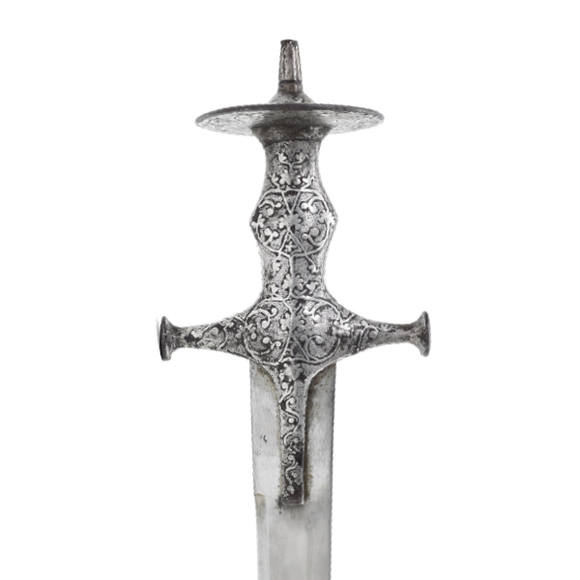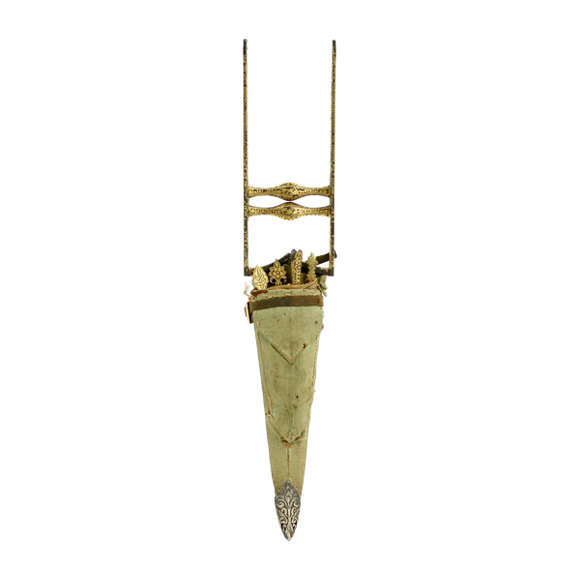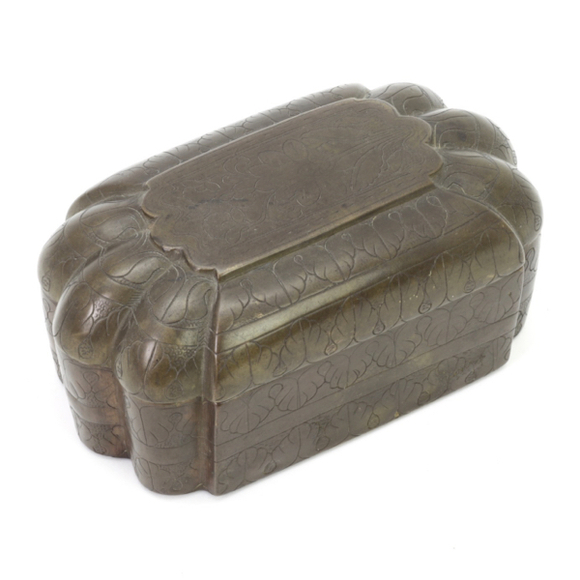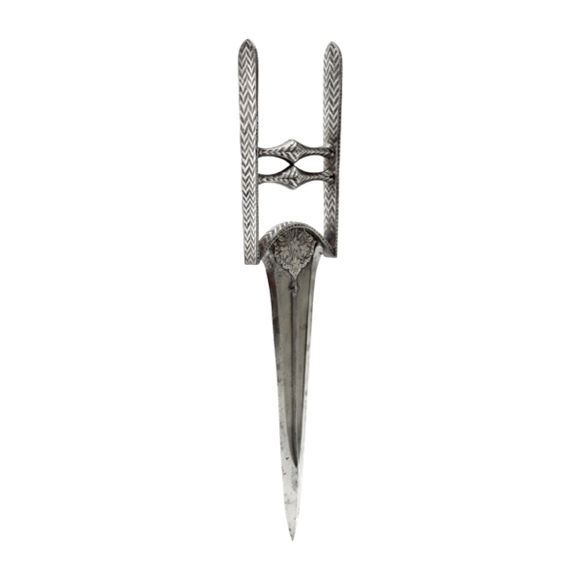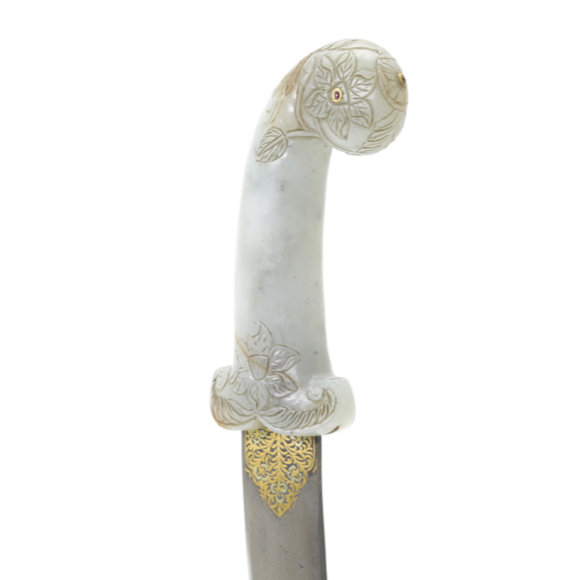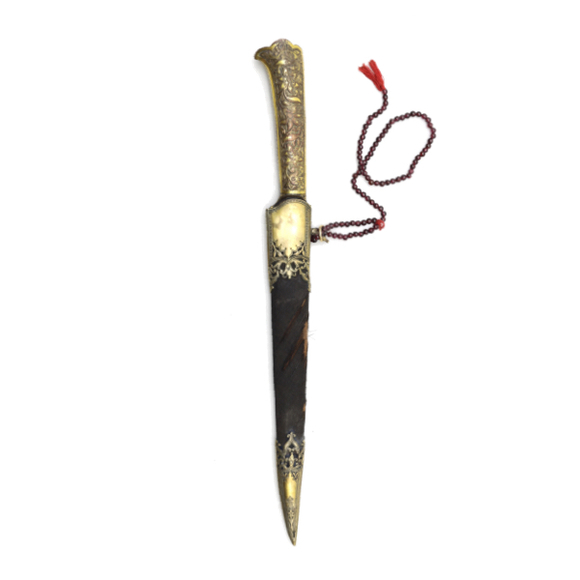Language: Hindi
Source: Lord Egerton of Tatton, 1896
Description
Sirōhī (सिरोही) is the name of a town in the southwest of Rajasthan, known for its sword making industry. It is also the name of a specific type of sword.
Sirohi the sword
The sirōhī is a rather heavy version of the talwar, with a flat ground, unfullered blade with secondary edge bevel and a long backedge. Usually made of fine-grained wootz steel, but the aesthetic was to burnish it bright with no visible pattern.

Two sirōhī swords I previously sold.
Their high quality hilts indicate the prestige that these swords enjoyed.
Top is a late 17th to early 18th century Delhi style hilt with true inlay.
Bottom a Marwari style hilt with fine overlay in silver and gold.
The latter once belonged to Mohta Bakhtawar Singh, chief Dewan of Bikaner in the mid 18th century.
"Every favourite weapon, whether sword, matchlock, spear, dagger, or bow has a distinctive epithet. The broad curved sword (tegha) is in use among the Hindu Rangars and Mahomedan Rajputs. The long cut-and-thrust blade, like the Andrea Ferrara, is not uncommon, but the chief favourite of all the various swords found throughout Rajputana is the Sirohi, a slightly curved blade, shaped like that of Damascus." 1
-Lord Egerton of Tatton, 1896
"The general Mahratta force is composed of ‘Jaghiredars’ or officers holding land like 'Sindia and Holcar, of 'nugdee' or corps paid by ready money, or of 'Tankardars’ holding assignments of lands resumable at pleasure, as the ‘paughers’ or commanders of cavalry. The troops comprise (1) ‘Bargirs’ mounted by the chief or government; (2) ‘Silladars ’ who mount themselves, and (3) ‘Yekandia’ (meaning single,) generally men of family, who, with a few attendants, go in quest of service. Of the two latter classes many seldom encumber themselves with anything but a pair of swords; one of a hard temper, consequently brittle and very sharp, called ‘serye’ (sirohi); the other more tough and less sharp named 'asseel’ (aṣíl)." 2
-Lord Egerton of Tatton, 1896
Notes
1. Lord Egerton of Tatton: Indian and Oriental Arms and Armour. Dover Publications; Revised edition, 2002. Page 105.
2. Ibid.
Sirohi the town
"Sword blades, daggers and other weapons of Sirohi were, at one time, famous throughout India, but somehow or other the manufacture of these articles decreased to a great extent. It is, however, pleasant to note that it seems to be reviving of late and tho demand, at least in Sirohi, seems to be increasing. Some of the blacksmiths have turned out this year a number of very good penknives and scissors, which are selling at cheaper rates than foreign-made articles of a similar nature. The enameling with gold and silver of the hilts and blades of swords and daggers and other iron articles is worthy of note, though the demand for these things is not at all great." 1
-Report On The Administration Sirohi State, 1907
"The only important manufactures are sword-blades, daggers, spears, knives and bows, the capital being the only place where the manufacture is carried on to any extent. The State has long been noted for the make and temper of its sword-blades, and Tod wrote that they were ‘as famed among the Rajputs as those of Damascus among the Persians and Turks.’ The work of inlaying with gold and silver on iron (at the capital) is also notable as it has secured medals at various exhibitions."
"Chhatrasal, son of Udai Singh, ascended the throne in 1754 V.E. (1697) and died in 1762 V.E. (1705). He was also called Durjan Singh and Durjan Sal. He was succeeded by his son Man Singh II, also known as Umed Singh. He had a great fancy for swords and passed an order that no sword of bad steel should be made in his State. The result of this was that the very best swords were manufactured in his dominions, and Sirohi swords, like the daggers of Lahore, became famous throughout the length and breadth of Hindustan. The sword made after the design of Man Singh is known in Rajputana as Mansahi."
-Sitaram Lala, 1920
Notes
1. Report On The Administration Sirohi State for the year 1906-1907. The Times Press, Bombay, 1907. Page 12.
2. Sitaram Lala; History Of Sirohi Raj From The Earliest Times To The Present Day. The Pioneer Press, Allahabad. 1920. Page 17 and 211.

